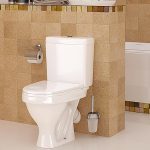Content
-
1 Hidden problems of houses from gas blocks
- 1.1 Hygroscopicity and low frost resistance
- 1.2 Cracks
Aerated concrete is a type of cellular material in which up to 85% is air. It has great popularity due to its good heat-insulating properties, light weight, ease of processing and affordable price. It is delivered in the form of large blocks and is used for private and professional buildings.

Hidden problems of houses from gas blocks
Despite the large number of positive qualities, aerated concrete has hidden flaws that appear during the operation of the house.
Hygroscopicity and low frost resistance
Aerated concrete is highly susceptible to absorption of moisture, which condenses inside the gas pores. At sub-zero temperatures, water freezes and expands, destroying blocks from the inside. Therefore, in the first winter the house should not be left unheated, especially if it does not have external decoration. To prevent the destruction of blocks, the walls are waterproofed and insulated.

One of the best ways is to create ventilated facades and facing with silicate brick. Ventilation gap from 2 to 4 cm. Using the same methods, insufficient frost resistance of aerated concrete is prevented. For quality materials, the number of freezing and thawing cycles is 50, and for aerated concrete only 35.

For interior decoration, it is best to use mixtures of gypsum, and as a topcoat, water-based paint.

Cracks
Cracks can appear both at the stage of rough works and after finishing. The main cause of their occurrence is the freezing of water inside the pores and their subsequent expansion. To prevent their appearance, use the following finishes: gypsum putty or plaster, pasting fiberglass of any density using special glue, coating of several layers of the finish putties. Such a finish will prevent the expansion of old cracks and prevent the formation of new ones.

Cracks also appear due to insufficiently strengthened foundation. This item is especially important if the building is being erected on heaving soil. As preventive measures, gravel, expanded clay, blast furnace slag, foam or mineral wool are used. Soil at the foundation site is completely removed, a trench breaks out around it and warmer soil is poured, it can be perlite sand.



-
 How to choose a table for the kitchen: size, shape, photo
How to choose a table for the kitchen: size, shape, photo
-
 Why you should not replace the ondulin brand horse with a metal one
Why you should not replace the ondulin brand horse with a metal one
-
 Built-in dishwashers
Built-in dishwashers
-
 Fireplace decoration: 4 cladding materials
Fireplace decoration: 4 cladding materials
-
 What watering can to choose for a shower: types, materials
What watering can to choose for a shower: types, materials
-
 Which toilet tank spends a lot of water and poorly performs its function
Which toilet tank spends a lot of water and poorly performs its function
-
 What types of electrodes are best used for inverter welding
What types of electrodes are best used for inverter welding
-
 Is OSB cooker really dangerous and can it be used indoors
Is OSB cooker really dangerous and can it be used indoors
-
 What consequences can there be if the laminate is laid in the kitchen
What consequences can there be if the laminate is laid in the kitchen
-
 What you should not make a roof in the north
What you should not make a roof in the north
-
 What roof will have to be repaired after 5 years of operation
What roof will have to be repaired after 5 years of operation
-
 Top reasons to abandon steel pipes in favor of plastic
Top reasons to abandon steel pipes in favor of plastic
New publications are published daily on our channel in Yandex. Zen
Go to Yandex. Zen


